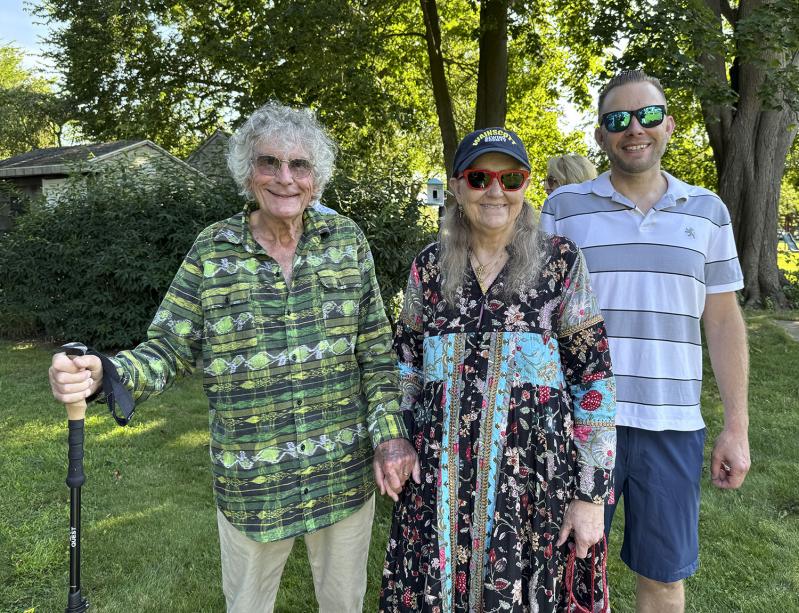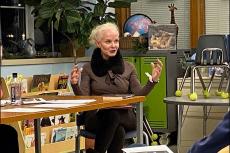At a July 20 garden party at the Sagaponack residence of Liz and Bryan Hedges, members and supporters of the Wainscott Heritage Project gathered to honor two of Wainscott’s most prominent residents: Dennis and Barbara D’Andrea.
As the setting sun charmed the 40 or so people in attendance, the atmosphere was so jubilant that no one from Wainscott seemed to mind that the party was actually taking place in the village next door.
The D’Andreas have been active as preservationists and community advocates for as long as the collective institutional memory of Wainscott serves. Carolyn Logan Gluck, a founder and co-secretary of the heritage organization, said that “in our estimation” the D’Andreas “have done more than anybody else to help us fulfill the mission of Wainscott Heritage Project.”
Mr. D’Andrea has been a member of the Wainscott Citizens Advisory Committee for some four decades, serving as a president for a time. For many years he was a regular at the monthly meetings of the Wainscott School Board, often giving history lessons derived from the school’s archive of meeting minutes. In recent years, his antique Model A has led off the Hamptons Pride parade — a relatively new tradition in East Hampton Village with foundational ties to Wainscott.
“He has carried on the legacy of the founding families,” Ms. Logan Gluck said. “He is a born storyteller, keeping Wainscott’s history alive. . . . To be told by Dennis that ‘you’re not all that bad’ is the pinnacle of acceptance.”
And it’s fair to say Ms. D’Andrea is one of the reasons the Wainscott Chapel is still standing as a community center today. She serves as treasurer of the Wainscott Sewing Society, which cares for the historic chapel and hosts events there, including rummage sales, ice-cream socials, a strawberry festival, and Halloween parades. She “fosters a traditional way of life” that “perpetuates the community’s character,” while also welcoming newcomers and “teaching them the ways of the hamlet,” Ms. Logan Gluck said.
Together, according to Wainscott Heritage Project members, the D’Andreas “keep the community spirit and traditions alive through their engagement.”
Mr. D’Andrea is a retired state judge who had careers as a journalist, editor, and college professor before seeking his law degree later in life. Ms. D’Andrea taught art for the Roosevelt School District and trained racehorses. They have lived in Wainscott full time since 2006, the year they both retired, at a house on Wainscott Hollow Road. The hamlet’s old general store sits at the edge of their property — no longer selling everyday necessities, of course, but rather adapted to house her art studio and his collection of classic cars.
But both have history that extends much further back than 2006. Mr. D’Andrea is a 13th-generation descendant of the hamlet, a direct descendant of the Osborn family. (Quick little genealogy lesson: Note the lack of an ‘e’ at the end of that surname — that’s how you distinguish the Wainscott Osborns from the others.) And Ms. D’Andrea is a third-generation resident — her grandparents bought property in the 1920s — who attended the hamlet’s one-room schoolhouse, a rite of passage for true Wainscott souls.
The D’Andreas also do missionary work through the East Hampton Presbyterian Church, making annual trips to Guines, Cuba, to support a “sister church” that has fewer resources.
This is the first year that the Wainscott Heritage Project has used its annual garden party to honor someone in this way. The group presented the D’Andreas with a framed print of Durell Godfrey’s iconic photograph of the Little House, the historic Wainscott structure around which the heritage organization galvanized when it was threatened with demolition in 2021. The group is hoping the Little House will soon find a home at 66 Main Street, the 30-acre property acquired late last year by East Hampton Town via the community preservation fund for $56 million.
In an interview a few days later, Ms. D’Andrea acknowledged feeling “a little awkward” but also very grateful for the honor.
“I don’t seek that kind of recognition. My feeling is you’re better off if you fly below the radar because you can get more done,” she said. “But it’s a wonderful feeling,” she added, to be on the receiving end of such high praise for the work she and her husband have done.
Over their years the D’Andreas have seen Wainscott evolve — and contrary to much recent discourse, the changes have largely been for the better, Ms. D’Andrea said. “You can actually have a life out here. When we were kids growing up, the only thing you did was look forward to getting out of here, because if you weren’t a farmer, there wasn’t really a career for you. To have careers, you had to leave.”
They “have seen a lot of things coming and going,” Ms. D’Andrea said, but living here “is such a gift.”




